THOMAS HART’S ROPE-WORKS BLACKBURN: An Industrial Link with the Eighteenth Century.
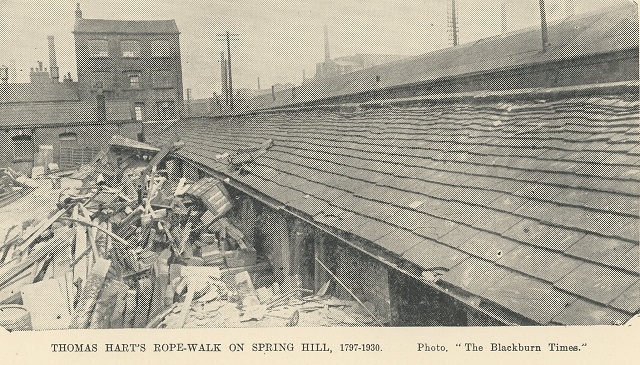
ROPE-WALK ON SPRING MILL
The Rope-works of Messrs. Thomas Hart, Limited, Blackburn, are second to none in the world in their special line, which is the production of cotton driving-ropes and bandings; and they have a continuous history coeval with the development of the town and trade of Blackburn extending back from the present day for a period of 141 years . Gillies’ map shows the rope-work in Mount-street built by Thomas Hart on the Vicar’s Glebe in 1797, as already recorded in these chapters of local history. The long, low shed, with a blank wall separating it from land now occupied by a footpath leading from Mount-street to the railway station, is seen, with two dwelling-houses at one end and a little warehouse at the other. The houses are within the garden enclosure on the summit of Spring Hill, and were probably built with the rope-walk. The little warehouse at the other end, in a short unnamed street branching out of Mount-street, was superseded about the middle of the nineteenth century by a four storey warehouse, still standing. The rope-walk is at present occupied as a store for empty barrels by Messrs. Dutton and Co., brewers, and its large yard, which was adorned with trees on Gillies’ Map, is shown by our present-day photograph to be a tipping ground for old timber and old iron. Before the railway station was built there was an additional (open-air) rope-walk, extending from Spring Hill in the direction of Jubilee-street, across the present Station Square. It is included in the ordnance survey of 1844. The covered rope-walk was (and is) 225 feet long, and the open-air rope-walk was 340 feet long, giving a total length of 56 feet, almost in a straight line. Old inhabitants tell of a Lovers’ Walk alongside these rope-walks, where now is the busy traffic of railways, tramways, motor-buses and taxi-cabs. In 1822 (and in 1844) the site of the railway fish market was a bowling green.
AN OLDER ROPE-WALK IN CABLE-ST
Before building the Spring Hill Works in 1797, Thomas Hart, the founder of the firm, is said to have had his rope-walk between the River Blakewater and Penny-street, on a plot of land to the east of St. John’s Church. It was probably an open-air walk, partly roofed over in a primitive fashion, running from the bank of the river, over the site of the Rechabites’ Hall, and along that portion of Cable-street, which is parallel to Brown-street and terminates at right angles to John-street. Cable-street at the present time consists of two short streets at right angles to each other, and the signboard “Cable-street” is at the corner of Brown-street, on an old stone wall which, according to tradition, had previously been the corner of Thomas Hart’s shop and warehouse. But when the name Cable-street first appeared on the map (in 1844) it was applied to the other arm of the street, running parallel to Brown-street, and all topographical considerations lead to the conclusion that this was the line of the rope-walk. Before the building of the Rechabites’ Hall there was room for a rope-walk 100 yards long along the very line to which the ordnance gave the name of Cable-street, but which is now a street of so little importance that the signboard has been taken away and fixed in another street at right angles to it.
THE ANCIENT CRAFT OF ROPE-MAKING
Rope-making is a prehistoric craft, and is as old as spinning if not as old as weaving, weavers originally having made their textiles from natural fibres unspun. Before the introduction of machinery to the cotton trade, hemp and jute were largely used for the making of ropes, but cotton has certain special advantages that have led to the development of the rope-making trade associated with the town of Blackburn. Spun yarns are twisted together, whether by hand or by machinery, to form “strands” and a rope consists of a certain number of strands. Three strands, “laid” or twisted together, form a hawser-laid rope, and three hawsers laid together with an opposite twist form a cable. The twist in each operation, from the unspun fibre to the finished rope, is in a different direction from that of the preceding one, and other ingenious devices are also adopted by the rope-maker to secure strength, parallelism, resilience, and other desired qualities. There is hard twisting and soft twisting, and there are ropes with a central core and ropes without it. The maker’s aim is to produce the article best suited for the purpose to which it has to be applied. For the making of a ship’s shrouds it was long ago found desirable to make a rope of four strands instead of the customary three, and a shroud-laid rope has always a central core. The special rope made by Thomas Hart, Limited, is Lambeth-laid, which differs both from the cable and the shroud in several important particulars, but is made both with four strands and with three.
A rope-walk is not very familiar to the boys of to-day, although Boy Scouts know more about knot-tying and splicing than their grandfathers did fifty or sixty years ago. Rope-making was largely hand work in olden days, the roper, in the course of his employment, walking backward and forward along the whole length of the shed, from which custom the works acquired the name of a rope-walk. It is remarkable how old-time methods persist. While it is possible nowadays to spin rope in various ways, the old rope-walk is found to have certain advantages which justify its retention, and anyone visiting Hart’s modern ropeworks in Lambeth-street, Blackburn, will see by the length of the wall beyond the offices and warehouses that the rope-walk is still retained. It is in fact 230 yards long and will make a rope of 800 feet in a single length. Since ropes are rarely asked for exceeding 50 feet, this leaves plenty of margin.
Many types of rope, bandings, twines and cords have been made at Hart’s, especially such as are required in the cotton trade. For example, the finest tightly-spun hempen cords required for healds and dobbies are made there, also twines, sashcords, weight-ropes, etc. But for seventy years they have specialised more and more on main driving-ropes, and to-day the Lambeth driving-rope is known and famed throughout the world wherever power-driven machinery is installed. In the 23rd volume of the “Encyclopaedia Britannica” there is given a drawing of the rope-race of a Lancashire cotton-spinning mill, with 38 Lambeth cotton driving-ropes,1 ¾” inch diameter, by which the energy of a 1,700 horse-power engine is transmitted to the whole mill. The number of driving ropes for a large mill seldom exceeds forty, but an instance could be quoted in which there are 67 driving-ropes on one fly wheel. In addition to an extensive home trade, Thomas Hart has built up a large trade in all parts of the world where power transmission is required, and Blackburn workmen have been sent out to splice and fit ropes in very many mills both at home and abroad. We give an illustration of a 1200 h.p. steam turbine driving a jute mill in India by means of Lambeth ropes.
From a paper read in London by Mr R.E. Hart to the members of the Association of Engineers-in-Charge, I gather that the use of ropes on main drives dates from about the year 1860, when a Belfast firm, Messrs. James Coombe and Co., introduced it. Leather belts were soon discarded, owing to their expense, and hemp ropes took their place. This was Thomas Hart’s opportunity. He knew from experience that cotton ropes would give better results than hemp ropes, which have a fibre of a harsh nature, for, when he died in 1861, he had for years been making small, plan-laid cotton ropes for driving Lancashire spinning mules. Five or ten years later the idea of driving a whole mill with ropes took hold in Lancashire, and the next Thomas Hart soon showed the local manufacturers that cotton ropes, made on the spot our of cotton yarn from their own mills, were superior to the hempen ropes at first used in the mills of Belfast and Dundee. New mills springing up at that time had their engines fitted with huge fly-wheels grooved for the reception of driving ropes; the system spread to other works besides cotton factories, and by producing ropes superior to anything made elsewhere the third Thomas Hart built up the present trade of world-wide scope and reputation. The firm of Thomas Hart was formed into a public limited company in 1928.
THOMAS HART, ROPER (1750 – 1802)
Founder of Hart’s Rope Works.
Thomas Hart, the founder of an old Blackburn business which has continued and prospered down to the present day, was born at Leyland about the year 1750. His father was killed in an accident while Thomas was in his infancy. In the year 1789 he is said to have come to Blackburn and commenced business as a roper in the fields beyond the River Blakewater, a little to the east of St. John’s Church, then in course of erection. St. John’s, the first offshoot of the Parish Church in the town, was built by subscription, and Thomas Hart’s contribution to the building fund was £100. He was a townsman of some consequence in 1796, when the Vicar Starkie obtained a special Act of Parliament to enable him to let the Vicarage Glebe for building purposes, and he was one of twelve townsmen who leased land from the vicar immediately, and erected their works or houses on the glebe in 1707. The plot taken by Mr Hart was on Spring Hill, close to the present railway station, and an account of his works there has already been given.
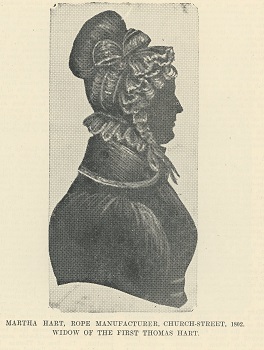 Thomas Hart married Martha Almond, and they had three children, Bridget, William and Thomas, all infants when he died in 1802, the girl being seven years old and the youngest boy (Thomas) only three. His will is dated 12th January 1802, and it was proved 27th April, 1802. He is described as Thomas Hart, of Blackburn, co.Lancs, roper and the first clause of the will reads as follows:- “I give and bequeath all my leasehold buildings and land situate Blackburn and which I hold under the Vicar of Blackburn, and also all my household goods and other my personal estate unto Henry Coupland, of Blackburn, grocer, and Thomas Ashburn of the same place, sizer of cotton twist, upon trust that they shall permit my wife Martha, so long as she shall remain my widow, to carry on the business which I now pursue for the benefit of herself and my three children.”
Thomas Hart married Martha Almond, and they had three children, Bridget, William and Thomas, all infants when he died in 1802, the girl being seven years old and the youngest boy (Thomas) only three. His will is dated 12th January 1802, and it was proved 27th April, 1802. He is described as Thomas Hart, of Blackburn, co.Lancs, roper and the first clause of the will reads as follows:- “I give and bequeath all my leasehold buildings and land situate Blackburn and which I hold under the Vicar of Blackburn, and also all my household goods and other my personal estate unto Henry Coupland, of Blackburn, grocer, and Thomas Ashburn of the same place, sizer of cotton twist, upon trust that they shall permit my wife Martha, so long as she shall remain my widow, to carry on the business which I now pursue for the benefit of herself and my three children.”
Mrs. Martha Hart, the widow, must have been a capable woman. She carried on the business during the minority of her children, gave her sons a good education, and brought them up in the fear and love of God. I regret that I cannot get a portrait of her husband, but there is an old silhouette of herself available which I am sure will interest the readers of this history. The name of Martha Hart appears in the earliest directory of Blackburn, published by Thomas Rogerson in 1818. She is described as Martha Hart, rope manufacturer, carrying on business in Church-street. This house and shop existed unaltered until 1871, and a photograph of it is given to-day. The Golden Lion hotel is shown next door, occupied by John Fisher. Mrs. Hart (and possibly her husband before her) held the premises on a yearly lease from Henry Sudell. They stood on a site of 207 square yards at the corner of Church-street and Ainsworth-street, for at that time Victoria-street had not been constructed, and Ainsworth-street began at the New Inn. They consisted of a dwelling-house, shop, backyard and outbuildings, and were situate “near the New Inn in Church-street and Ainsworth-street.”
When the Sudell Estate was broken up and sold by auction in December, 1827, many of the tenants in Church-street purchased the property they had previously rented, among them being the Harts, for in the following May this freehold house and shop in Church-street, were conveyed “to William and Thomas Hart and their trustee” in perpetuity.
WILLIAM AND THOMAS HART
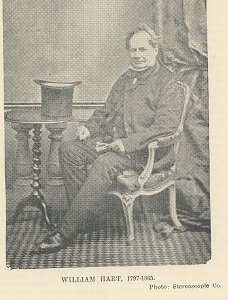 By the terms of the first Thomas Hart’s Will, quoted above, the rope-works, and other property were divided among his three children in the year 1820. Baines’s History of Lancashire, in 1824, shows William and Thomas Hart carrying on their father’s business at 23, Church-street. The modern number is 49. In a directory of 1852 it is given as 52. William and Thomas Hart, the two sons of the founder of the firm, were in partnership for forty years, but William left the business in 1861.
By the terms of the first Thomas Hart’s Will, quoted above, the rope-works, and other property were divided among his three children in the year 1820. Baines’s History of Lancashire, in 1824, shows William and Thomas Hart carrying on their father’s business at 23, Church-street. The modern number is 49. In a directory of 1852 it is given as 52. William and Thomas Hart, the two sons of the founder of the firm, were in partnership for forty years, but William left the business in 1861.
Thomas died the same year, and a third Thomas succeeded to it. William was the elder of the two partners, having been born in 1797. His first wife was Elizabeth Haworth, daughter of Richard Haworth, a Northgate draper who went into the cotton business at Spring Hill Mill.
Their eldest son, Thomas Hart, built Bridgewater Mill, on the canal in Higher Audley, about the year 1865. One of the daughters of this Thomas married Judge (Sir Edward) Parry. William’s second wife was a Miss Hopwood. She had two sons. The younger, Peter Hopwood Hart, became Vicar of Salesbury. He married Alice Hutton, second daughter of J. C. Hutton and two of their sons became clergymen. The descendants of William Hart are numerous and can be traced to the third and fourth generation at the present day. William died at Spring Hill in 1865.
THOMAS HART, J.P. (1799 – 1861)
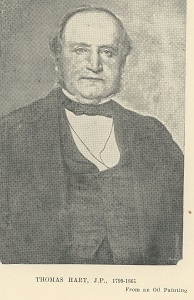 The coming-of-age of the second Thomas Hart, in May, 1820, is the event that marks the date when William and Thomas Hart succeeded to their father’s (and their mother’s) business, in Church-street and on Spring Hill. It was the year in which the old Parish Church was pulled down. His mother had sent him to Blackburn Grammar School, in the old Churchyard, and afterwards trained him, together with his elder brother, for the business that their father had left them. He became a sound Churchman, and, in politics a Liberal Conservative. He was for many years a teacher at the Thunder Alley Sunday School, but went to St. John’s School when it was built in 1844-45, and became treasurer of the sick society there. Mr. Hart’s connection with St. John’s Church was a long and intimate one, and he is described as a staunch, consistent and untiring supporter. He was an earnest and indefatigable advocate of the education of the working classes, a friend of the poor, and a promoter of many valuable institutions of the town, more particularly the Strangers’ Friend Society, of which he was treasurer for nearly 30 years.
The coming-of-age of the second Thomas Hart, in May, 1820, is the event that marks the date when William and Thomas Hart succeeded to their father’s (and their mother’s) business, in Church-street and on Spring Hill. It was the year in which the old Parish Church was pulled down. His mother had sent him to Blackburn Grammar School, in the old Churchyard, and afterwards trained him, together with his elder brother, for the business that their father had left them. He became a sound Churchman, and, in politics a Liberal Conservative. He was for many years a teacher at the Thunder Alley Sunday School, but went to St. John’s School when it was built in 1844-45, and became treasurer of the sick society there. Mr. Hart’s connection with St. John’s Church was a long and intimate one, and he is described as a staunch, consistent and untiring supporter. He was an earnest and indefatigable advocate of the education of the working classes, a friend of the poor, and a promoter of many valuable institutions of the town, more particularly the Strangers’ Friend Society, of which he was treasurer for nearly 30 years.
During the distress among handloom weavers in 1826-27, following the introduction of the power loom, he was an active and energetic member of the local committee formed to obtain funds from London and elsewhere and distribute them in relief. He was one of the signatories to a memorial asking for a town’s meeting to consider the formation of the Blackburn Savings Bank (established March 31, 1831), and later he was appointed a member of the committee of management of the bank (1835) and trustee about 1840.
The Borough of Blackburn was incorporated in 1851, and William Hoole, the Returning Officer for the first municipal election, selected six of the leading gentlemen of the town to represent him as deputy returning officers in the several wards. Mr. Hart being the deputy for St. Mary’s, which had 456 voters. The other deputy returning officers were: Christopher Parkinson, St. John’s, 534 voters; Henry Shaw, Trinity, 505; George Dewhurst, Park Road 421; Miles Baron, St. Peter’s, 448; and John Baynes, St. Paul’s, 643 voters. Mr Hart was a candidate himself for St. John’s Ward, and, along with Benjamin Brierley, civil engineer, was elected at the head of the poll, to serve for three years. Thomas Dutton and William H. Cartwright were elected for this ward for two years. John Thwaites and D.W. Forrest, for one year. Thomas Thwaites was the alderman for the ward. In his address to the electors Mr. Hart stated that he was an old inhabitant, and had taken an active part for nearly thirty years in the town’s improvements. He promised his utmost energy and zeal in carrying out the objects of the charter of incorporation and in promoting the interests and welfare of his native town. When his term of office expired at the end of three years he resolutely declined to accept re-election.
In 1852 a Borough Bench was formed and Mr. Hart’s name appeared in the first list of borough magistrates. The names were; William H. Hornby, William Eccles, Dr. Richard Martland, John Livesey, John Sparrow, James Forrest, Robert Hopwood, junior, Christopher Parkinson, Thomas Hart and William Pilkington. Mr. Hart was assiduous in his duties as a magistrate as long as he lived.
Thomas Hart, (the second Thomas in this genealogy) was twice married. He first married Alice, daughter of Robert and Mary Slater, who died April 3, 1851, aged 49 years; and secondly, Anne (or Nancy) Hutton, born 1815, died 1896. By his first marriage he had three sons, the Rev. Robert S. Hart (1838-1884); Thomas, ropemaker, of Town Hall-street (1840-1916), and John (1841-1848). Whittle records that “In the burial ground of St. John’s Church, north-east corner, is placed a neat funeral pedestal, palisaded, with blank escutcheons and the following inscription: ’Sacred to the memory of Alice, wife of Thomas Hart, who died April 3rd, 1851, aged 49 years’. Mr Hart lived, in 1851, at the corner of St. John’s-place (or terrace) and James-street, exactly opposite the north-east corner of the churchyard. He died there, August 14, 1861, and lies buried both his wives in the family vault. The second wife survived him by thirty-five years. The inscription on the north side of the monument recording his burial is almost unreadable, having been worn away by the weather but there is a marble mural tablet in St. John’s Church, at the east end of the south aisle, inscribed as follows – “As a tribute of affection and esteem this tablet is erected by John Baynes to the memory of his sincere and attached friend and brother-in-law. Thomas Hart, of this town, who died on the 14th of August, 1861, in the 65th [63rd] year of his age. He was many years a warden of this church, a town councillor and justice of the peace for this borough. His character reflected the graces of the sincere Christian. He was a steadfast friend to the poor, full of alms-giving, just and upright in all his dealings, and equitable and considerate in all his decisions. As in life he was deservedly respected, so was his death deeply and universally lamented”. A local paper at the time said; - “He was highly respected by all ranks and parties of his fellow-townsmen as an individual of unimpeachable integrity, genteel manners, and extensive benevolence. His friendships were many and ardent, and he goes to his grave sincerely lamented as a man of the right stamp – an honour to his native town – and as a person whose greatest ambition was to be useful in his day and generation.”
In 1859 the Corporation decided to widen Ainsworth-street at its junction with Church-street, and open Victoria-street into Church-street. Twelve years later they purchased a strip of land for the purpose from Thomas Hart, along the Ainsworth-street frontage of their shop, and constructed a footpath 7ft.6” wide, besides slightly widening the roadway. Victoria-street had already been cut through to Church-street and the new footpath at Hart’s corner at once became one of the busiest thoroughfares in the town. Mr. Hart retained the right to build cellars under the path, and, pulling down the old house and shop, he erected the present three-storey shops and Hart’s Chambers on the remainder of the site. This street improvement completed the approaches to the New Market Square, begun in 1844.
Our portrait of the second Thomas Hart at the age of 60 is reproduced from an excellent oil painting made by Philip Hoyol.
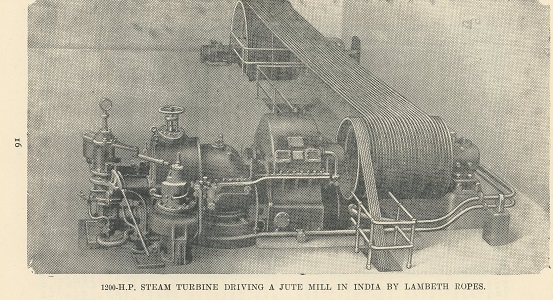
THOMAS HART J.P. (1840 – 1916)
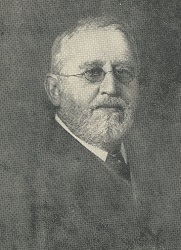
The third Thomas Hart, ropemaker, of Blackburn, died so recently as 1916, and was well known to many townsmen of the present generation, being actively associated with the religious, charitable and social life of the borough, as well as a leader in local trade and commercial organisations. As a boy he was educated at Preston Grammar School, where he was the contemporary of Sir Harry Hornby. On leaving school he was apprenticed by his father to Messrs. Pilkington Bros, & Co., at Park Place Mills, where they undertook to teach him “the business of cotton spinning and manufacturing”. It was not intended that he should become a manufacturer, but his father at that time was building up a new trade in the production of cotton driving-ropes for mills, and wisely considered that a thorough knowledge of the cotton trade would serve his son in good stead. Thomas completed his five years’ apprenticeship on the 23rd of February, 1861. A month before that his father had become the sole proprietor of Hart’s Ropeworks, and to that important position the third Thomas succeeded when his father died in August of the same year, subject to a liability for his elder brother Robert’s share. Blackburn was growing rapidly and trade was expanding, in spite of the serious stoppage caused by the Cotton Famine. The third Thomas Hart played his part in building up the town and trade of his native borough. His works on Spring Hill, though not too small, were seventy years old and, in view of the expansion of trade and great developments in the use of cotton driving-ropes, he determined to build a new up-to-date ropewalk on a new site, and fit it with new machinery. So it happened that, in 1866, he leased for 999 years a site in Lambeth-street from the Ecclesiastical Commissioners, who had succeeded the Archbishop of Canterbury as trustees for the Rectorial Glebe of Blackburn, and there he erected a new rope-walk, which has since acquired world-wide fame as the “Lambeth Ropeworks”. The four-storey warehouse at the end of the Mount-street Rope-walk continued to serve him for some years longer, but in 1874 he built a new shop, offices and warehouse, in Town Hall-street, where he carried on business to the end of his life.
Though he took no active part in the corporate life of the borough, nor in political contests (he was a Conservative), he was always alert in matters affecting the trade of the town, and in philanthropic organisations. For forty-five years he was treasurer of the Blackburn Guardian Society for the Protection of Trade, and, when the Chamber of Commerce was formed in 1887 he became one of his earliest directors.
He was the first treasurer of the Blackburn Ragged School and a life-long subscriber. He and Mr. James Dixon were the first to start a fund for the building of the Orphanage at Wilpshire, and later, he gave to that institution a piece of land adjoining the Orphanage site. He was a member of the Board of Management of the Blackburn Savings Bank, the Committee of Blackburn and East Lancashire Royal Infirmary, and a subscriber to many other local charities, and he will be chiefly remembered for his varied activities in religious and philanthropic work. He became a Justice of the Peace for the County in 1903.
His interest in St John’s began at the age of 3 ½ years, when he was taken as a child to see Joseph Feilden, lord of the manor, lay the foundation-stone of St. John’s Schools. He worshipped at St. John’s for a great part of his life, but eventually transferred his seat to St. Silas’s. He was one of the first trustees of St. Silas’s, and afterwards became a sidesman. Among the items of church work in which he engaged were the building of St. John’s Vicarage, of which he was the secretary, and the erection of St. Matthew’s Church and vicarage, being a member of the building committee and a liberal subscriber. His interest in churches was not confined to one parish or one town, for he was a governor of the Dean Close Memorial School, Cheltenham, and a trustee of All Saints’ Church, Blackpool. For fifty years he was a local secretary for the Society for Promoting Christianity among the Jews, and a steady supporter of such organisations as the British and Foreign Bible Society, the Church Missionary Society, and the Church Pastoral Aid Society.
Thomas Hart (son of Thomas and grandson of Thomas) was born, at the corner of St. John’s-place, on the 24th of August, 1840, and was the second son of his parents. His elder brother Robert having entered the Church, he was destined to succeed to the family business. He married, in 1877, Hannah, eldest daughter of John C. Hutton, cotton spinner, the senior partner in the firm of Hutton & Baynes, India Mill, Blackburn. Before her marriage Miss Hutton was a teacher in the Sunday Schools built by Canon Birch, and was a close friend of Mrs Birch and her sister Miss Wilson, of fragrant memory. She survived her husband by twelve years, for he died December 10, 1916, she on March 17, 1928. They had three sons and two daughters, and there are both children and grandchildren living. Their residence was “Brooklands”, West Park-road, and they are buried at Salesbury.
THE LAMBETH ROPE-WORKS IN 1930
MR. ROBERT EDWARD HART, M.A.
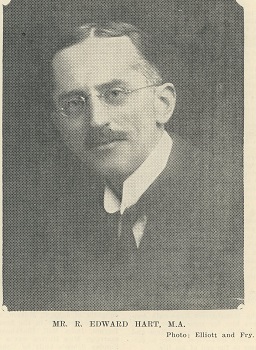 Mr. R. Edward Hart, M.A., the present head of the firm of Thomas Hart, Limited, is the eldest son of the third Thomas Hart. He was educated at Horris Hill School, near Newbury, Rugby School and Pembroke College, Cambridge. He took his degree with honours in mechanical science, and was made a member of the Institute of Mechanical Engineers in 1916. He has taken up much of his father’s work in connection with the church and trade organisations, having been treasurer of the Blackburn Orphanage since 1908, and treasurer of the Blackburn Guardian Society and the Church Missions to Jews for the Deanery of Blackburn since 1916. He was chairman of the Blackburn Chamber of Commerce in 1922-23, and also been its treasurer. He was elected a vice-president of the Chamber in 1924. He represented Blackburn at the conference of Chambers of Commerce of the Empire held at Montreal in 1903, and has travelled in four continents on behalf of his firm. He is also a Fellow of the Royal Numismatic Society, and has a liking for early printed books and manuscripts. He was elected a member of the Public Library Committee in 1929. He represents the University of Manchester on the Board of Governors of the Blackburn High School for Girls, and is a trustee of St. Silas’ Church.
Mr. R. Edward Hart, M.A., the present head of the firm of Thomas Hart, Limited, is the eldest son of the third Thomas Hart. He was educated at Horris Hill School, near Newbury, Rugby School and Pembroke College, Cambridge. He took his degree with honours in mechanical science, and was made a member of the Institute of Mechanical Engineers in 1916. He has taken up much of his father’s work in connection with the church and trade organisations, having been treasurer of the Blackburn Orphanage since 1908, and treasurer of the Blackburn Guardian Society and the Church Missions to Jews for the Deanery of Blackburn since 1916. He was chairman of the Blackburn Chamber of Commerce in 1922-23, and also been its treasurer. He was elected a vice-president of the Chamber in 1924. He represented Blackburn at the conference of Chambers of Commerce of the Empire held at Montreal in 1903, and has travelled in four continents on behalf of his firm. He is also a Fellow of the Royal Numismatic Society, and has a liking for early printed books and manuscripts. He was elected a member of the Public Library Committee in 1929. He represents the University of Manchester on the Board of Governors of the Blackburn High School for Girls, and is a trustee of St. Silas’ Church.
He gave up the shop in Town Hall-street and sold it, when, in 1925, he built new offices and warehouses as an extension of the rope-works in Lambeth-street, and in 1928 he turned the business into a public limited company, of which he is the managing director.
It is an interesting fact that the rope-walk in Lambeth-street, built by his father, is on the Rectory glebe, while the offices and warehouse built by himself are on the Vicarage glebe. This important boundary line is indicated by the joint in the two buildings, where the original door to the rope-walk is seen at the end of the footpath on the easterly side of Lambeth-street.Died Sept. 21, 1946, aged 68.
Left £370,823
Article transcribed by June Riding, Community History Volunteer, July 2020 from:
J.G. Shaw's
History of Thomas Hart's Rope-Works Blackburn, Established 1789. With Biographical Notes On Four Generations Of The Hart FamilyReprinted from “The Blackburn Times,” June 1930
back to top

